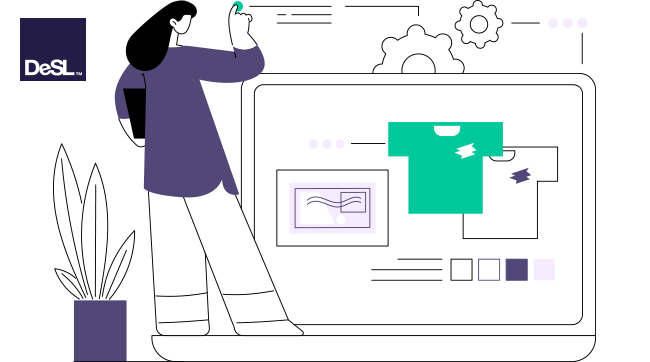In today’s fast-moving retail, fashion, apparel, footwear, and accessory industries, brands need speed, collaboration, and visual clarity to stay ahead. Traditional tools like spreadsheets and static presentations can’t keep up. Modern teams need more detail and flexibility to work effectively.
DeSL’s Digital Planning Boards are a powerful solution. We built it as a robust merchandise planning tool. This helps teams in design, development, merchandising, and supply chain work together in one visual workspace. Whether you’re launching a new line, adjusting assortments, or building mood boards, Digital Planning Boards bring everything together.
This article explains how Digital Planning Boards are changing the way brands plan, visualize, and collaborate. They have become essential planning software for today’s businesses.
What Are Digital Planning Boards?
Digital Planning Boards are cloud-based, visual collaboration platforms specifically built for the fashion and apparel industry. They combine planning tools, line sheet creation, mood board functionality, and data analysis into one centralized system.
A digital planning board provides your team with one shared space. Everyone can see the same information, updated in real time, unlike disconnected spreadsheets or scattered PDFs. As visual merchandising software, it helps users align seasonal collections and review financial data. It also allows them to create strong visual concepts all in one place.
Key Features of DeSL’s Digital Planning Boards
Here’s how DeSL’s planning software helps retail, fashion, apparel, and footwear brands streamline their planning and development process:
-
Visual Line Planning for Fashion
The platform serves as a powerful line planning software, letting teams build and manage line plans visually. You can:
- Plan collections by season, category, or region
- Create assortment grids that update in real-time
- Drag and drop products into visual layouts
- Filter and sort by status, cost, margin, or supplier
This visual-first approach eliminates guesswork and makes it easier to spot gaps or duplications in your assortment.
-
Digital Line Sheets
Eliminate reliance on static PDFs and lengthy email chains. With integrated digital line sheets, you can:
- Generate live line sheets instantly
- Share secure links with internal teams or suppliers
- Update styles, pricing, or images without creating new versions
- Keep a centralized library of finalized and in-progress sheets
Digital line sheets save time, reduce errors, and give your team better visibility at every stage.
-
Fashion Mood Board Creator
A key part of any creative process is the development of style direction and inspiration. DeSL includes an intuitive fashion mood board creator where you can:
- Build mood boards using AI-generated visuals or Google image search
- Upload your own sketches, swatches, or photos
- Add sticky notes, comments, and specialized font styles
- Collaborate with other creatives and merchandisers in real time
This is where ideas become actionable. With a few clicks, your initial concepts can become full-blown product strategies.
-
Integrated 3D and Adobe Illustrator Files
Planning extends beyond sketches. Use the board to view 3D prototypes or import Adobe Illustrator files directly from your design team. This helps bridge the gap between concept and creation and lets cross-functional teams give feedback without switching platforms.
Say Goodbye to Spreadsheets
If your current workflow involves:
- Dozens of spreadsheet tabs
- Outdated versions of product specs
- Long email threads with missed updates
- Limited visibility between departments
…it’s time to rethink your tools.
Spreadsheets never handled the complexity of fashion planning effectively. They are unable to visualize designs and do not provide real-time change tracking. And they certainly don’t allow for dynamic, creative collaboration.
Apparel planning software like DeSL’s Digital Planning Boards solves these problems. We designed it specifically for how retail, fashion, apparel, and footwear teams work.
A Merchandising Collaboration Platform That Brings Teams Together
In most fashion companies, departments work in silos. Design hands off to development, which hands off to production, which updates merchandising.
This causes misalignment, delays, and confusion.
DeSL’s merchandising collaboration platform eliminates silos by allowing everyone—designers, developers, merchandisers, sourcing teams, and suppliers—to work from the same visual board.
The system updates in real time, and everyone sees the same data. Communication becomes more efficient. Decisions occur more rapidly. The entire product lifecycle achieves greater connectivity.
How to Use Digital Planning Boards in Your Existing Workflow
Whether you’re a small brand or a global enterprise, Digital Planning Boards are flexible enough to fit your needs. You can:
- Use them as a standalone fashion planning software
- Integrate with your existing PLM or ERP systems
- Roll them out team by team or across the full organization
- Customize templates for specific product types or collections
DeSL’s solution works smoothly with your current tech stack. You can also use it with the full DeSL PLM suite for complete digital transformation.
Built for Retail, Fashion, Apparel, and Footwear
Unlike generic planning tools, DeSL’s apparel planning software was created specifically for the retail, fashion, apparel, and footwear industries. That means:
- Terminology and templates designed for workflows
- Integration with key tools like Illustrator, 3D modeling, and PLM
- Visual layouts that reflect real merchandising boards
- Support for colorways, sizes, fits, and seasonal variations
No superfluous workarounds. No ineffective solutions. Just purpose-built tools designed to support the way your team operates.
Smarter Planning = Better Results
With Digital Planning Boards, fashion teams can:
- Launch collections faster by cutting down planning cycles
- Improve accuracy by eliminating duplicate or outdated data
- Increase creativity by making concepting easier and more fun
- Boost collaboration by keeping all stakeholders connected
- Drive profitability by aligning plans with financial goals
These benefits compound over time—making your entire organization more responsive, agile, and competitive.
